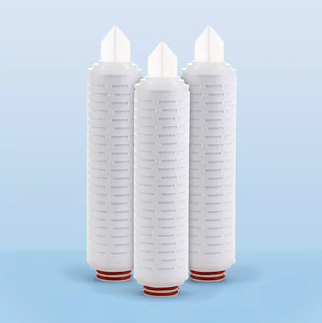What’s the difference?
Water filters are rated on ther capability to remove particles of a soecifc size from a fuid but the problem is that an array of very diferent methods arapplied to specify performance in this way.
Pore siz ratings refer to the siz of a particular particle or organism retained by the flter media to a specific dearee of eficiency For example. a flterthat is marked 10 micron has some ability to capture particle as small as 10 micrometers. However, you do not know precisely what this meansuniess you also have a description of the test methods and standards used to determine the flter ratino. The two most used reported media ratinoare nominal and absolute micron rating
ABSOLUTE RATING
The absolute rating of a flter refers to the diameter of the largest spherical particle, commonly expressed in micrometers (mm), which wil passthrough the fiter under laboratory conditons. t represents the pore opening size of the medium flter. Fiter media with a precise and consistent poresize or opening thus, in theory, have an exact absolute rating
The absolute rating shouldnt be confused with the biggest particle passed by a filter under operating conditions: the absolute rating clearlydetermines the size of the largest glass bead which wil pass through the flter under very low pressure differentals and nonpulsating conditions
For the most part this does not usually apply in practice. pore size is modifed by the form of the filter element and it is not certainly consistent withthe actualopen areas. In addition, the actual form of the contaminants are not rounded and the two linear dimension of the particle can be very muchsmaler than its nominal one, permitting it to pass through a very much smaler hole (e. cylindrcal particles with a thickness less than the slotopening of the filter).
The passage of oversize particles in this manner relies very largely on the size and shape of the opening and on the depth over which fitering irovided. Most of filters generate a flter bed: contaminants gather on the surface impart a blocking action decreasing the permeabilty of the elemerad developing filter eficiency. When the blocking is so severe that the pressure drop is too much, the flow rate through the system decreaseriously This explains wmy the pertormance of a flter can often exceed its gven rating based on the pertormance of a clean element and why teiqures can differ widely with different test cond tions on identical elements.
t may be argued that the term absolute rating is not a practical descrption. Strictly speaking the term absolute indicates that no particle larger thatthat rating can pass through the flter, lmiting the type of media to those of consistent pore size where they show 100% retention of particles.
NOMINAL RATING
The nominal rating refers to a fliter that s able ot cutting off a nominated minimum percentage by wreight of sold partcles of a speciic contaminanyeater than a stated micron size. normaly exoressed in micrometers imml. For example. 90% of 10 micronlt also serves as a nominal elicientiqure,or more correctly, a degree of fltration Process conditions ike operating pressure, concentration of contaminant etc, have a compelling efeoon the retention of the filters. Many flter manufacturers use comparable tests but, due to the lack of consistency and reproducibility of the basinethod, the use of nominal ratinas has fallen into disfavor

